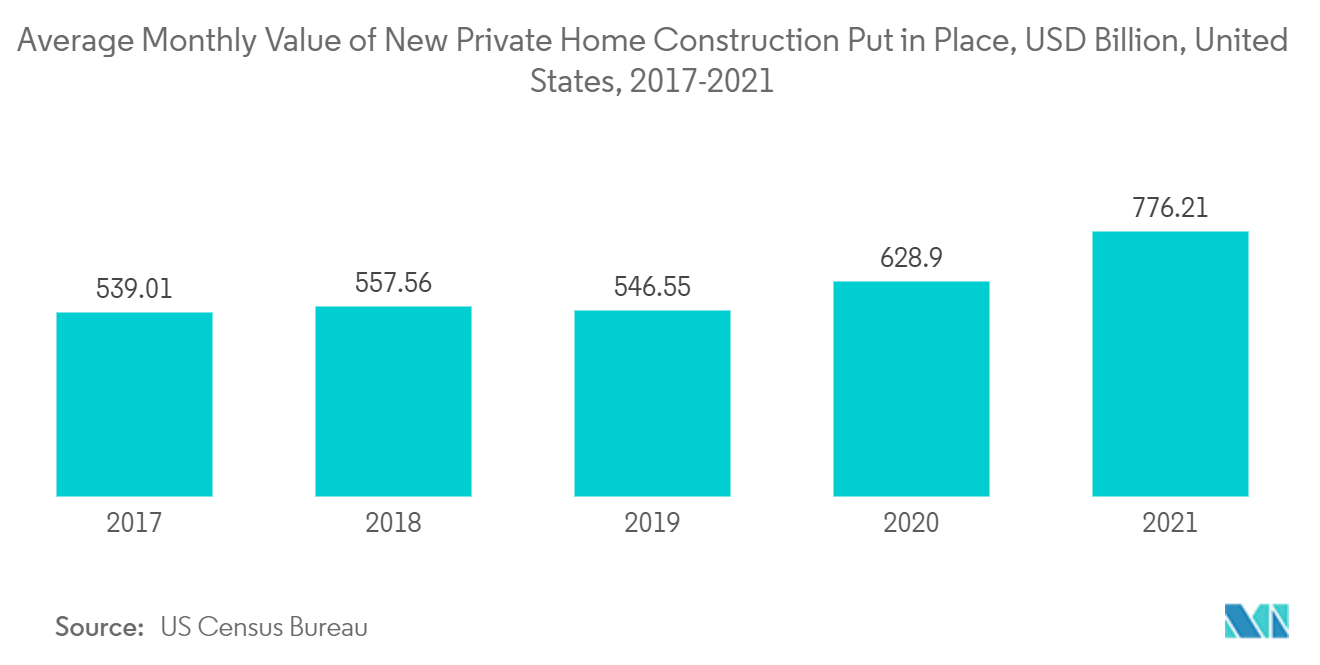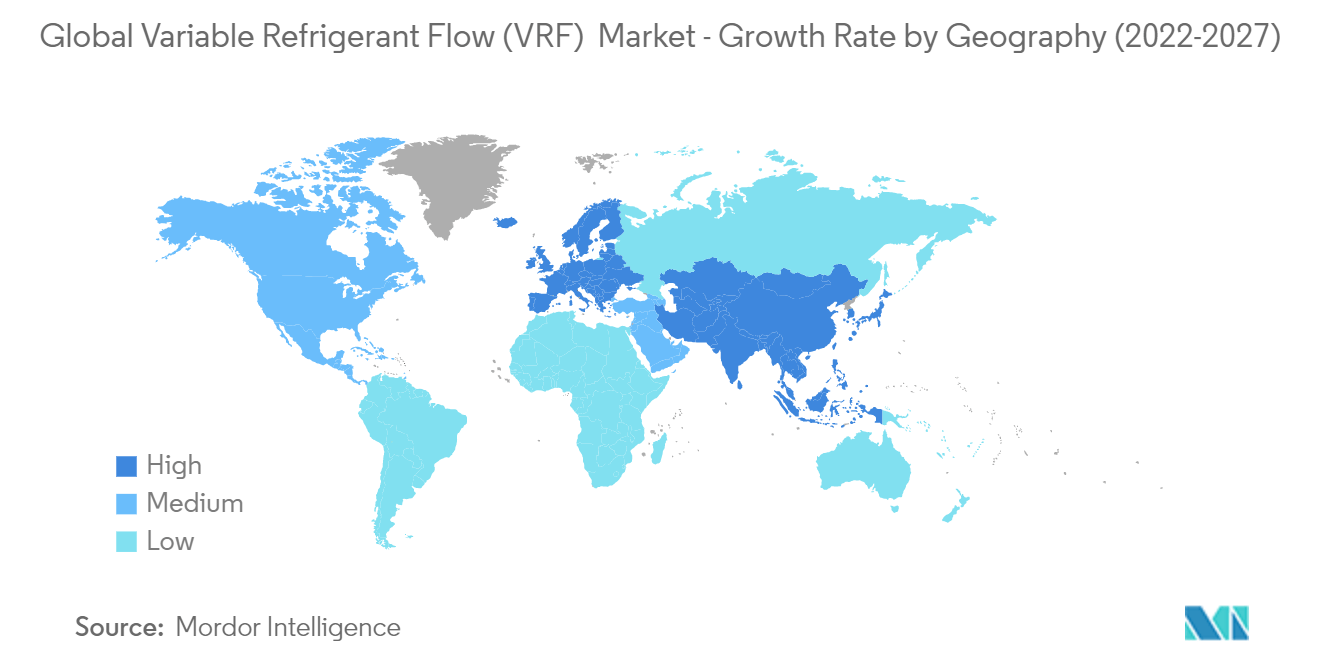Market Trends of Global Variable Refrigerant Flow (VRF) Industry
This section covers the major market trends shaping the Variable Refrigerant Flow (VRF) Market according to our research experts:
Residential Segments Plays a Prominent role in Market Growth
- Air supply VRF is widely used in Asia and Europe and is well-liked worldwide. It is quickly gaining market share in North America's residential and commercial sectors. The use of VRF in Passive House projects or other projects looking to reduce their site's reliance on fossil fuels is a growing trend. Due to the current push for complete electrification by numerous municipalities, cities, and even states, the latter is a particularly hot topic. Building electrification aims to convert all energy uses to electricity alone as the power system becomes more environmentally friendly and less dependent on fossil fuels. By using an air source heat pump rather than a gas-driven furnace or boiler, VRF can help achieve this goal.
- According to US census Bureau, Between 2002 and 2021, public residential building investment in the US increased dramatically in value. Over USD 9 billion were spent on residential construction projects by the public sector in 2021, a minor decline from 2020. The highest rise occurred in 2020, when public residential spending increased to USD 9.19 billion from USD 6.89 billion, representing a significant increase. Over the next few years, it's anticipated that the total cost of newly built homes in the US will rise.
- To meet the demands of the customer, the firms are developing new products. For Instance,in February 2022, In order to maintain its pace and sharpen its emphasis on clients in the light commercial HVAC segment, Carrier China has introduced the new XCT8 variable refrigerant flow (VRF) series. The new XCT8 series is produced in Carrier's Nanhai, Foshan factory with an unwavering dedication to quality, technology, and energy efficiency in order to satisfy the needs of Chinese and international customers. The new XCT8 direct current frequency conversion VRF systems close gaps in some earlier generation models and surpass China's GB 21454-2008 national energy efficiency standard for multi-connected air conditioner heat pump units.
- The government policies in the developments of the housing projects will significantly create opportunity for the VRF Market to grow. For instance, in March 2022, Al Hamra, a developer in Ras Al Khaimah, announced an AED1 billion (UDS 272 million) residential project as part of a broader recovery in the UAE's housing market. Falcon Island will be created within Al Hamra Village, a residential neighborhood with a mall, a yacht club, and hotels. The new project is being launched as the UAE's housing market continues to recover from the coronavirus-induced slump. New government efforts such as residency for distant workers and pensioners and the expansion of the 10-year golden visa program have boosted the market.
- Moreover, the Smart City initiative that the government launched has been pushing the construction sector strongly. The South Korean infrastructure ministry has previously announced a consortium of South Korean construction companies to build an eco-friendly USD 4 billion residential city in Kuwait. Primarily led by Posco A&C and Hyundai Architects and Engineers Associates Co., the consortium would be building a smart city that is environment-friendly, well-organized, and connected.

Europe Holds the Prominent Share of the Market
- Most commercial structures, from little stores and cafes to big office complexes and public areas, use VRF systems. VRF zoning ensures that energy is only used to cool, or heat occupied offices. Due to their quiet indoor units and ability to maintain precise temperature control, VRF systems guarantee the most comfortable and productive work environment.
- To expand their presence and capture a wide market share, the companies are launching and making available in Europe. For instance, in February 2021, Carrier introduced its XCT7 VRF air conditioning system in Europe. The range includes sizes from 4 to 26hp in single- and dual-fan, side discharge, top discharge, and full discharge heat recovery heat pump units. To achieve 104 horsepower with up to 64 indoor units per outside system, up to four outdoor units can be coupled. Twelve indoor units are offered, including round-way, 1-, 2-, and 4-way cassettes. Innovative features include a centrifugal oil separator that improves refrigerant distribution balance, a black-coated fin technology that increases corrosion resistance, anti-liquid shock compressor technology that lowers the failure rate from liquid shock, and a 10-stage oil return technology that ensures a smooth supply of lubricant.
- Furthermore, In July 2021, The new DVM S2 Variable Refrigerant Flow (VRF) outdoor air conditioning unit from Samsung Electronics will be released globally. It combines with interior units to deliver the company's patented WindFree Cooling anywhere without the pain of direct cold air flow indoors. The outdoor-installed technology of Samsung's sixth-generation Digital Variable Multi air conditioner, model number DVM S2, allows for greater versatility and functionality. It allows connection with 64 Samsung interior air conditioning units to provide the best comfort possible without unwelcome cold breezes. In Europe, DVM S2 is now offered and works with Samsung's 1Way, 4Way, 4Way 600600, and wall-mounted variants.
- To meet the demands of the customers the firms in the region are providing different products so that they can enhance their market share. For example, In addition to providing a large capacity range of up to 270 kW in a single central system, Bosch VRF Air Conditioning Systems also employs a modular design approach with space-saving outside units, fashionable indoor units, and sophisticated controls. This high-efficiency product line is appropriate for air-conditioning facilities, including hotels, businesses, hospitals, restaurants, villas, and schools. The advantages of a VRF system include connecting to building management systems and providing individual room control and centralized control.
- The COVID-19 epidemic significantly negatively impacted the VRF systems business, just like it did in any other industry. On the one hand, procuring the raw materials and components needed to produce VRF Systems, delivering finished goods, and luring workers out of quarantines were all issues that VRF system makers had to deal with. However, the market growth has been positively impacted by increasing automation in various manufacturing organizations and integrating the Building Automation System (BAS) for schedules and alarms.
- Moreover, With affluent countries like the United Kingdom, France, Germany, Denmark, Switzerland, Luxembourg, Belgium, and other Scandinavian countries EU has one of the highest per capita income and GDP in the world. According to IMF, the European Union Gross Domestic Product in 2020 was USD 15,167 billion and is expected to reach USD 21,183 billion by 2026. The region's per capita income is also high, with seven European countries being in the top seven in the world. This allows the European citizens to spend higher on building automation and smart integration of the living space which will drive the studied market


